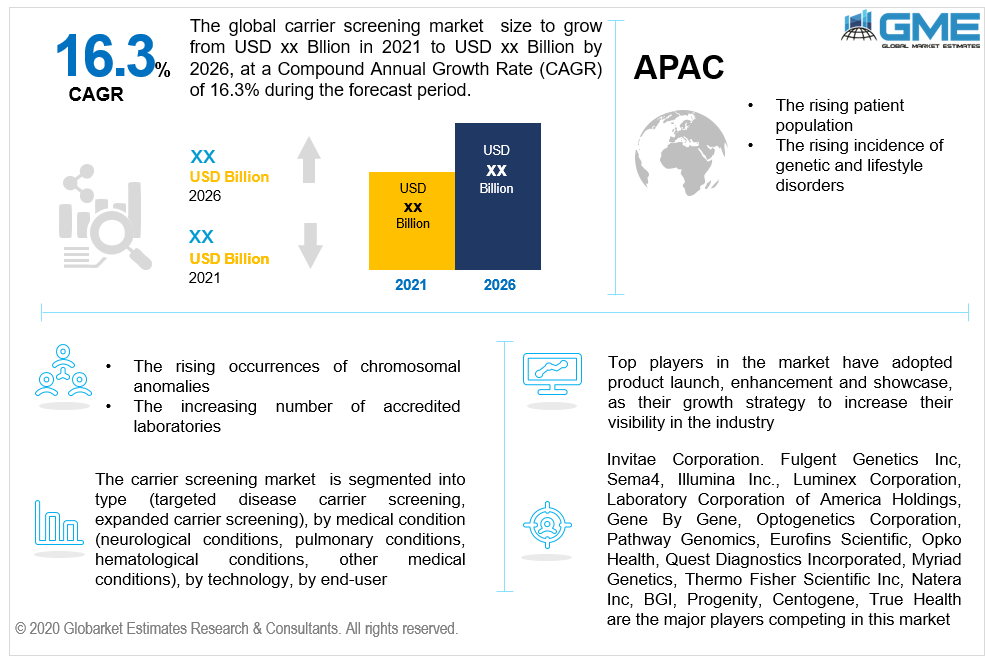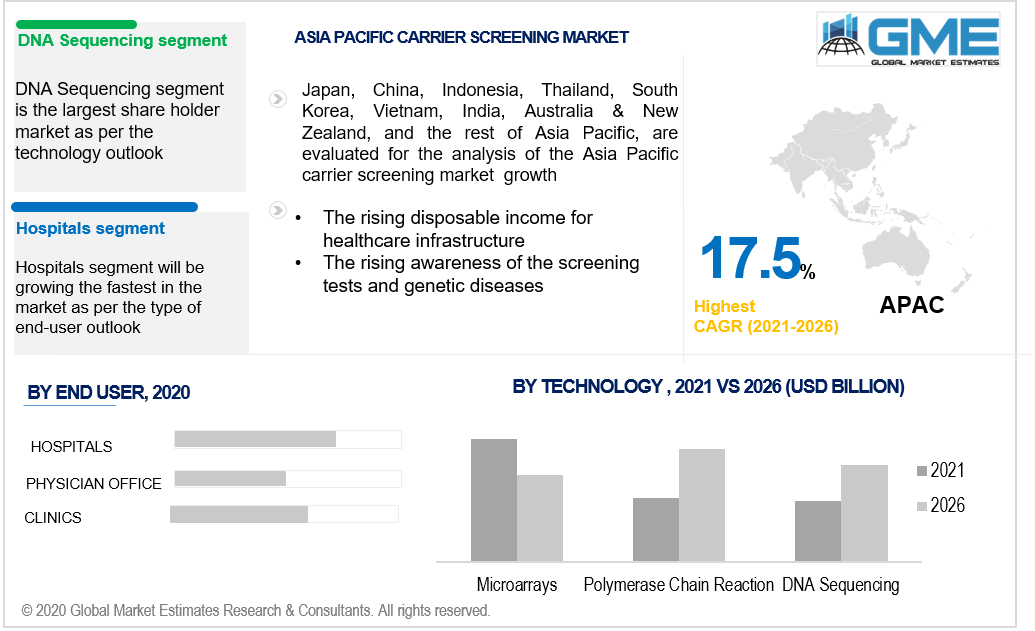
Global Carrier Screening Market Size, Trends, and Analysis- Forecasts To 2026 By Type (Targeted Disease Carrier Screening, Expanded Carrier Screening), By Medical Condition (Neurological Conditions, Pulmonary Conditions, Hematological Conditions, Other Medical Conditions), By Technology (Microarrays, DNA Sequencing, Polymerase Chain Reaction), By End-User (Reference Laboratories, Hospitals, Physician Offices, and Clinics, Others), By Product & Service (Services, Products), By Region (North America, Asia Pacific, CSA, Europe, and the Middle East and Africa); End-User Landscape, Company Market Share Analysis & Competitor Analysis
Carrier screening is a genetic test used to determine if a healthy individual is a carrier of any recessive gene or genetic disorder. It offers life-long data about the reproductive risk of a person and the likelihood of having a child with a genetic disorder. The development is expected to be driven by a rising occurrence of chromosomal anomalies and an increasing demand for carrier screening during the forecast timeline. It is also anticipated that rising technical developments and increasing awareness of carrier screening would increase market demand exponentially. Furthermore, a growing number of carrier screening tests coupled with the increasing prevalence of genetic diseases for targeted chromosomal conditions will drive the demand to expand exponentially from 2021 to 2026.

The two types of carrier screening are targeted disease carrier screening and expanded carrier screening. The expanded carrier screening segment is further divided into pre-designed panel testing and personalized panel testing. Factors such as the growing use of high-throughput technologies such as sequencing & microarrays and guidelines for the use of extended carrier screening can be attributed to the largest share of this segment.
Products and services are the market segments. The services segment was the largest market share in 2020 which can be attributed to the growing number of accredited laboratories, and rising awareness regarding carrier screening tests.
This market can be segregated into three segments according to the technology, namely microarrays, DNA sequencing, and polymerase chain reaction. Compared to the other technologies, the dominating segment will be the DNA sequencing segment of this market. There is a growing need to detect multiple genes at the same time, which is driving demand for NGS.
Reference laboratories, hospitals, physician offices, and clinics, among others, are various end-users of the market. As of 2020, the market for the hospital segment will expand over the expected timeframe at a high CAGR. Some of the key factors contributing to the growth of this end-user segment are the rising patient population, the rise in medicare reimbursement for clinical tests conducted at hospitals, and the advent of advanced diagnostic tests.

Over the projected timeframe, the North American region is expected to dominate the market. This can be attributed to the increasing number of tests done for early diagnosis of the inherited condition and other genetic disorders. On the other hand, the Asia Pacific region will be the fastest-growing region, owing to the presence of a huge patient population and the continuous economic growth of the APAC countries.
Fulgent Genetics Inc, Sema4, Illumina Inc., Luminex Corporation, Laboratory Corporation of America Holdings, Gene By Gene, Invitae Corporation, Optogenetics Corporation, Asuragen, Pathway Genomics, Eurofins Scientific, Opko Health, Quest Diagnostics Incorporated, Myriad Genetics, Thermo Fisher Scientific Inc, Natera Inc, BGI, Progenity, Centogene, True Health are the major players competing in this market
Please note: This is not an exhaustive list of companies profiled in the report.
In November 2019, Asuragen, launched the AmplideX PCR/CE SMN1/2 Plus Kit, which helps detect variants associated with SMN1 gene duplication, and helps quantify SMN1 and SMN2 related numbers.
We value your investment and offer free customization with every report to fulfil your exact research needs.
The Global Carrier Screening Market has been studied from the year 2019 till 2026. However, the CAGR provided in the report is from the year 2021 to 2026. The research methodology involved three stages: Desk research, Primary research, and Analysis & Output from the entire research process.

The desk research involved a robust background study which meant referring to paid and unpaid databases to understand the market dynamics; mapping contracts from press releases; identifying the key players in the market, studying their product portfolio, competition level, annual reports/SEC filings & investor presentations; and learning the demand and supply side analysis for the Carrier Screening Market.

The primary research activity included telephonic conversations with more than 50 tier 1 industry consultants, distributors, and end-use product manufacturers.

Finally, based on the above thorough research process, an in-depth analysis was carried out considering the following aspects: market attractiveness, current & future market trends, market share analysis, SWOT analysis of the companies and customer analytics.

Tailor made solutions just for you
80% of our clients seek made-to-order reports. How do you want us to tailor yours?
OUR CLIENTS